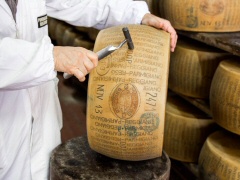|
 This great cheese is worthy of all that praise it recieves: it is very natural, very healthy, very delicious and very consistent. It is wonderful by itself in chunks, shaved over or grated into foods, cooked or uncooked. It has been so good at doing so many things for so long - over 800 years - that it has earned the nickname in the dairy industry, "The King of Cheeses." This great cheese is worthy of all that praise it recieves: it is very natural, very healthy, very delicious and very consistent. It is wonderful by itself in chunks, shaved over or grated into foods, cooked or uncooked. It has been so good at doing so many things for so long - over 800 years - that it has earned the nickname in the dairy industry, "The King of Cheeses."
 Parmigiano-Reggiano is a hard, dry cheese made from skimmed or partially skimmed cow's milk. It has a hard pale-golden rind and a straw-colored interior with a rich, sharp flavor. Parmigiano-Reggianos are aged at least two years. Those labeled stravecchio have been aged three years, while stravecchiones are four or more years old. Their complex flavor and extremely granular texture are a result of the long aging. Parmigiano-Reggiano is a hard, dry cheese made from skimmed or partially skimmed cow's milk. It has a hard pale-golden rind and a straw-colored interior with a rich, sharp flavor. Parmigiano-Reggianos are aged at least two years. Those labeled stravecchio have been aged three years, while stravecchiones are four or more years old. Their complex flavor and extremely granular texture are a result of the long aging.
But there is one big problem. As good as the cheese is, and as famous as it is, you rarely actually get to eat it - even when you think you are. The English translation of the cheese is Parmesan, and when you buy it in England you get Parmigiano-Reggiano. It's the law. The American translation is also Parmesan, but when you buy it here, you could be getting almost anything - except usually Parmigiano-Reggiano.
 By law, Parmigiano-Reggiano is allowed to contain only three very simple ingredients: milk (produced in the Parma/Reggio region and less than 20 hours from cow to cheese), salt, and rennet (a natural enzyme from calf intestine). Three other ingredients, Cellulose Powder, Potassium Sorbate, and Cheese Cultures are not found in Parmigiano-Reggiano - they are completely illegal in its production. Yet all three are in Kraft 100% Grated Parmesan Cheese (I'm not sure if that means it is supposed to be 100% "parmesan" or simply 100% grated, which it certainly is). It's far enough from the real thing that Kraft was legally forced to stop selling its cheese labeled Parmesan in Europe. By law, Parmigiano-Reggiano is allowed to contain only three very simple ingredients: milk (produced in the Parma/Reggio region and less than 20 hours from cow to cheese), salt, and rennet (a natural enzyme from calf intestine). Three other ingredients, Cellulose Powder, Potassium Sorbate, and Cheese Cultures are not found in Parmigiano-Reggiano - they are completely illegal in its production. Yet all three are in Kraft 100% Grated Parmesan Cheese (I'm not sure if that means it is supposed to be 100% "parmesan" or simply 100% grated, which it certainly is). It's far enough from the real thing that Kraft was legally forced to stop selling its cheese labeled Parmesan in Europe.
.
|